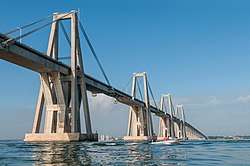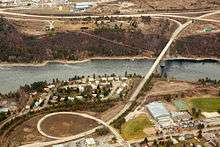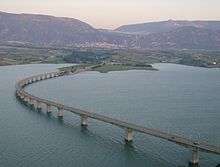Riccardo Morandi
Riccardo Morandi (1 September 1902 – 25 December 1989) was an Italian civil engineer best known for his innovative use of reinforced concrete and prestressed concrete, although over the years some of his particular cable-stayed bridges have had some maintenance trouble.

Amongst his best-known works are the General Rafael Urdaneta Bridge, an 8 km (5 mi) cable-stayed bridge crossing Lake Maracaibo in Venezuela; a similar bridge in Genoa commonly known as Ponte Morandi (officially Viadotto Polcevera), which partially collapsed in 2018 for reasons under investigation; and the Subterranean Automobile Showroom in Turin.[1]
Career



Morandi was born in Rome. After his graduation in 1927, Morandi gained experience in Calabria working with reinforced concrete in earthquake-damaged areas. On his return to Rome to open his own office, he continued with his technical exploration of reinforced and prestressed concrete structures and embarked on the design of a series of novel cinema structures and bridges. His numerous later works include his work on the Fiumicino Airport (Rome) in 1970, and Pumarejo bridge (Colombia) in 1974.
Morandi was appointed professor of bridge design both at the University of Florence and the University of Rome, became a Fellow of the "Royal Society for the Encouragement of Arts, Manufactures and Commerce" (FRSA) in 1963,[2] and get a honorary doctorate in architecture by Technical University of Munich (T.U.M.) in 1979.[3]
Criticism of the cable-stayed bridges by Morandi
Morandi's cable-stayed bridges are characterised by very few stays, often as few as two per span, and often with the spans constructed from prestressed concrete rather than the more-usual steel.[4]
Although these bridges are often impressive, they are less economic than bridges with multiple stays and have therefore been of little influence on other engineers.[5] Bridges by Morandi have proved to require extensive maintenance and repairs over the years to pass bridge safety inspections, and cables embedded in concrete are difficult to inspect.
On his General Rafael Urdaneta Bridge in Venezuela - where the cables of the stays are not covered with prestressed concrete (as instead intended from the initial project, and optimal for Morandi)[6] - several exposed cables snapped from rapid corrosion, and all the stay-cables were replaced just 18 years after construction.[7]
In 2016, Ponte Morandi in Genoa (Polcevera Viaduct) had been described as a "failure of engineering", with escalating maintenance costs to keep it safe.[8] In reality since the 1970s Morandi acknowledged, and reported, the incorrect structural response of his Genoa bridge and the related safety risk, mentioning an unexpectedly fast corrosion as a possible reason for the problems, and requiring corrective work.[9][10][11]
Pier number 9 of the bridge collapsed on 14 August 2018, causing 43 fatalities. The other two stayed-piers remained standing, as did the other eight non-stayed piers. The cause of the collapse was still under investigation more than one year later.
Morandi's similar but smaller Wadi el Kuf Bridge, in Libya, during October 2017 was closed for 2 days for safety reasons after inspections identified potential fractures in the bridge (After the alert, road transport engineers inspected the bridge and said that it needed only emergency maintenance and was safe; then was open again for light traffic, while local security officials are stopping heavily-loaded trucks from crossing in groups).[12][13] Similar security alert follow in August 2018, but about this not other specific information is available about the bridge status (if closed or still open, exactly structure problems).[14]
Projects
Major works (bridges only) by Morandi is shown below:[15]
-panorama3.jpg)
1957 - Florence, Italy



.jpg)


- Morandi was also involved in the construction of the Powerline crossing of Messina Strait.
References
- www.detailsinsection.org/wp-content/uploads/2014/07/6Architettura-Ingegneria.pdf
(in Italian and English) "LA CONCEZIONE STRUTTURALE Ingegneria e architettura in Italia negli anni cinquanta e sessanta" - 2008
"Riccardo Morandi and the V Pavillion for Torino Esposizioni" @ page 239 - Riccardo Morandi was elected a Fellow of the Society on March 11th 1963. This followed his presentation of a paper in January the previous year, "Engineering and Architecture" (Journal of the Royal Society of Arts, Vol. 110, No. 5066 (JANUARY 1962), pp. 75-92 - https://www.jstor.org/stable/41367048 ) - The RSA's records
- TUM - Fakultät für Architektur Technische Universität München - Ehrendoktoren "Riccardo Morandi (1979)" https://www.ar.tum.de/de/fakultaet/auszeichnungen/ehrendoktoren/
- A document of 1978 explaining the modern concrete cable-stay bridge of Morandi
- Fernández Troyano, Leonardo (2003). Bridge Engineering: A Global Perspective. Thomas Telford Publishing.
- (in Italian) L'invenzione di Morandi "...i 6 cavalletti bilanciati sostengono le travi intermedie di “serraglia”; lo strallo è più sottile e sempre matericamente omogeneo, a conferma del suo ruolo chiave nella figura, compiuta e perfetta. Ma lo strallo omogeneizzato è destinato a lasciare il posto a un più ordinario fascio di cavi di acciaio, prodotto secondo il brevetto Felten & Guilleaume, come confermato nell’ultima relazione di calcolo firmata da Morandi, nel febbraio 1960, nonostante il plastico sulla copertina ne esalti ancora la matericità." https://www.ingenio-web.it/21020-linvenzione-di-morandi
- De Rincon, Oladis et al. (October 2001). "Inspection and Repair of Lake Maracaibo Bridge Suspension Cables". Materials Performance. 40 (10): 34–38.CS1 maint: uses authors parameter (link)
- Taylor, Matthew (14 August 2018). "Genoa bridge collapse: 'Unusual' span had seen frequent repair work". the Guardian. Retrieved 15 August 2018.
- (in Italian) Corriere della Sera, Venerdì 31 agosto 2018, Pagina 12 – "La relazione sull'opera e quell'inquietudine dell'ingegner Morandi" – di Giuseppe Pullara. (The Engineer Remo Calzona, in 1976 student of Morandi, speaks of the problems he saw on the Genoa bridge in that year, when Morandi involved him in analysis about that.)
- Morandi, Riccardo (1979). "The long term behaviour of viaducts subjected to heavy traffic and situated in an aggressive environment: the viaduct on the Polcevera in Genoa" https://webapi.ingenio-web.it/immagini/file/byname?name=riccardo-morandi-durabilita-ponte-pp.pdf
- (in Italian) "Ponte Morandi, quell'allarme inascoltato del 1981" https://genova.repubblica.it/cronaca/2018/08/29/news/ponte_morandi_quell_allarme_inascoltato_del_1981-205155625/
- AlHarathy, Safa (26 October 2017). "Authorities in east Libya close Wadi el Kuf Bridge for safety reasons". Libya Observer. Retrieved 15 August 2018.
- "Cracked Beida road bridge declared safe" https://www.libyaherald.com/2017/10/27/cracked-beida-road-bridge-declared-safe/
- See Talk:Riccardo Morandi#proposal of editing about Wadi el Kuf Bridge paragraph
- Note: for some other '50-'60 works, not only bridges, check Italian language website atlante.iuav.it, set "Morandi Riccardo" on the "Ingegnere" menù, then press "Ricerca" button.
- Kinnaird Bridge - 1965 - Castlegar, BC http://staging.waymarking.com/gallery/image.aspx?f=1&guid=5c25df29-6e8d-44fc-aa10-d9f705a62dfa
- General Rafael Urdaneta Bridge partially collapsed in 1964 after being struck by a tanker "The collison between "Esso Maracaibo" & the Bridge". Auke Visser's Other Esso Related Tankers Site. Retrieved 15 August 2018.
- Ponte Morandi in Genoa is part of the Polcevera Viaduct, four cable-stayed spans (maximum 280 m), partially collapsed on 14 August 2018
- The 1970 bridge is on the left side; in right side new bridge build in 2006
- Wadi el Kuf Bridge, with three cable-stayed spans; for seven years, its 281 m central span was the longest concrete cable-stayed bridge span in the world
- three cable-stayed spans
- Irminio Bridge (Ponte Costanzo/Viadotto Irminio) http://www.highestbridges.com/wiki/index.php%3Ftitle%3DIrminio_Bridge
External links
| Wikimedia Commons has media related to Riccardo Morandi. |
- Riccardo Morandi at archINFORM
- Riccardo Morandi at Structurae
- Short biography (in Italian)
-001.jpg)


.jpg)

